Introducing bamboo, a material still not fully understood by many.
Characteristics of Bamboo
-

Bamboo is a plant belonging to the Poaceae (true grasses) family. Its shoots appear around mid-April and grow to full size in just over a month. After reaching full size, bamboo does not continue to increase in breadth or height—in other words, its thickness does not increase over the years as with trees. There are records of bamboo growing more than one meter in a single day.
-

Every year, bamboo sends out new rhizomes (subterranean offshoots) as it continues to reproduce. Bamboo flowers once every 120 years or so, and each time this happens the flowering bamboo grove as a whole withers and dies, requiring about ten years to return to healthy growing condition.
-

Bamboo grows well in warm, humid climates, and in Japan it is found throughout various parts of Honshu (except for Aomori Prefecture), Shikoku and Kyushu.
Types of Bamboo
The following three principal types of bamboo are often used as materials.
-
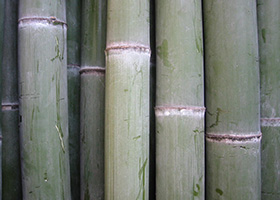
Mosochiku bamboo
This is the largest bamboo grown in Japan. Mosochiku bamboo (Phyllostachys edulis) is said to have been introduced to Japan in 1736 from China via the Ryukyu Kingdom. Its culm height reaches about 20 meters (66 feet) and its diameter about 20 centimeters (8 inches). Mosochiku is a tall variety of bamboo cultivated for its edible shoots, which are generally eaten in the spring.
-
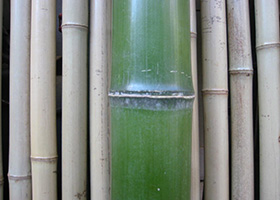
Madake
Although madake bamboo is said to have originally come from China, it has grown in Japan since ancient times. Its culm height reaches about 20 meters (66 feet) and its diameter about 13 centimeters (5 inches). The joints between the culm sections of madake are soft and therefore easy to cut, making this type of bamboo suitable for use in bamboo ware and other such applications. Because the outer skin of madake is free from hair, it is used for wrapping meat, rice balls and other foods as part of Japanese culinary custom.
-
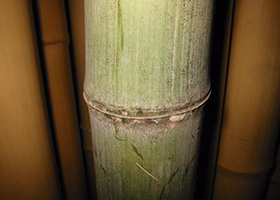
BlackHenon Bamboo
Although bamboo is said to have originally come from China, it has grown in Japan since ancient times. Its culm height reaches about 20 meters (66 feet) and its diameter about 10 centimeters (4 inches). Compared with madake, bamboo features pale-green coloring throughout that gives it a more whitish appearance. Because this type of bamboo can be divided into very small strips, it is often used to make tea whisks (stirrers with numerous fine strands of bamboo).
Kyoto's Ties with Bamboo
Kyoto is surrounded by mountains and has a unique basin climate characterized by hot-and-humid summers and chilly winters, which contribute toward the area's fame as a high-quality bamboo production center.
Since the Heian Period (794–1185), bamboo has been used widely as a material for building construction (pillars and wall framework material), fences, bamboo blinds and other applications. From the end of the Kamakura Period (1185–1333) through the Muromachi Period (1336–1573),
it became a vital material in the manufacture of tea utensils used in the tea ceremony (which flourished during this time), thus making bamboo even handier and more widely utilized than before.
In these ways, bamboo developed deep ties with Kyoto, a city blessed with an ideal climate and natural features as well as a rich cultural backdrop.
Past eras have seen the creation of outstanding bamboo products and new bamboo processing techniques, which have been preserved and passed down from generation to generation to this very day.
Kyo-meichiku
(Genuine Kyoto Bamboo)

Kyoto's bamboo products and assembled-bamboo craft products are characterized by their emphasis on the intrinsic qualities of the original material.
Products made using the famously high-quality bamboo produced in Kyoto are certified as traditional craft products by Kyoto Prefecture under the name "Kyo-meichiku" (Genuine Kyoto Bamboo).
The high degree of perfection in the base materials is what transforms the inherent beauty of bamboo into traditional craft products.
Kyo-meichiku includes four types of bamboo: shiratake, zumenkakuchiku, gomatake and kikkochiku.
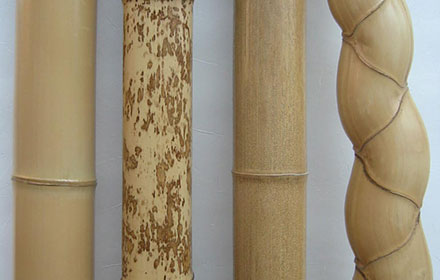
Traditional Bamboo Processing Techniques
A wide variety of traditional techniques exist for processing bamboo and forming it into products. Baskets made of split, woven bamboo and other such products are particularly well known.
The following is an overview of the primary processing techniques for bamboo, which are unfamiliar to many people.
Shiratake Processing (Heating: Dry-method Oil Removal)
-
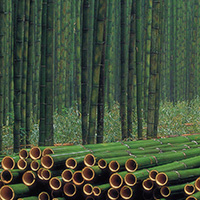
Harvesting (Cutting)
Harvesting (cutting) of bamboo is carried out in carefully managed and maintained bamboo groves. The harvested bamboo is dried naturally to remove water content.
-
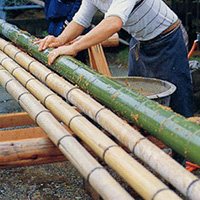
Washing
The outer surface of harvested bamboo is washed to remove dirt.
-
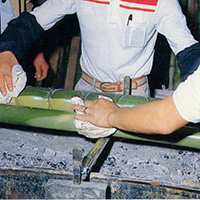
Oil Removal
The surface of the bamboo is heated using a charcoal fire, gas flame or similar to bring out it oils, which are then carefully wiped away with a cloth. A straightening process known as tame is usually implemented at the same time as oil removal, in which the bends and curves of the bamboo are corrected while the material is still hot.
-
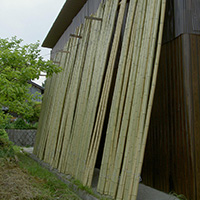
Drying
The bamboo is exposed to sunlight in sufficient amounts to dry it evenly throughout. The surface of the finished shiratake material has a glossy appearance, and over time it takes on an amber-colored translucency. This painstaking process is carried out for each cut of green bamboo to give it the whitish appearance of shiratake bamboo material.

